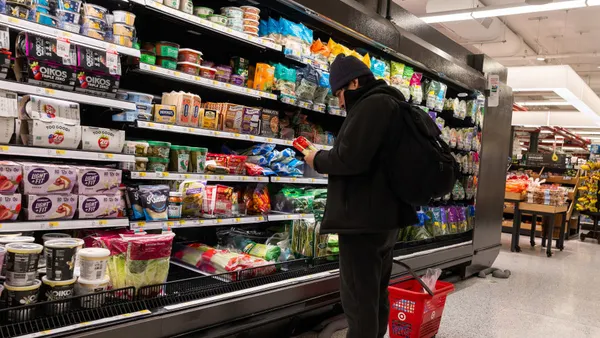As private brands boom and grocers continue to cook up new store brands, supermarkets could do more to attract younger consumers, according to new research.
“The [grocery] industry does see itself as slightly misaligned when it comes to capitalizing on the importance of appealing to those younger consumers for growth” in private brands, Steve Markenson, vice president of research and insights at FMI – The Food Industry Association, said during a media briefing last week.
More than 80% of surveyed grocery industry executives said focusing on younger consumers is important, yet only 20% said the performance of private brands for that customer cohort has been “excellent or very good” so far, according to FMI research.
Gen Z consumers, for example, are craving fresh foods, but their spending doesn’t match their purchasing intent, signaling a disconnect, according to Advantage Solutions and Daymon’s 2024 Private Brand Intelligence Report.
Gen Z shoppers surveyed by Daymon said adding more healthy food to their diets (64%) and consuming more fresh food (50%) are the top two changes they made compared to last year. But fresh foods only account for about a quarter (27%) of their basket spend, the report noted.
A fresh approach to product innovation
Grocers need to get creative with their fresh food assortments to whet Gen Z’s appetite, the Daymon and Advantage Solutions report suggests, noting that convenience, quick meal solutions, social media trends, unique flavors, global cuisines and low prices are some of the main drivers behind their shopping.
“Gen Z craves fresh, vibrant food experiences, yet current shopping habits are painting a different picture,” that report says.
For example, best-in-class retailers are serving a diverse fresh salsa variety, pre-chopped vegetables with culinary influences like Asian stir-fry and unpasteurized fresh juices, the report said. Grocers can also turn to eye-catching and trendy produce items like donut and galaxy peaches, purple broccoli and cucamelons — grape-sized fruits resembling tiny watermelons.
Products such as spicy guava lemonade, cut mango with tajin or chili, and hot honey rotisserie chicken can help appeal to the 53% of Gen Z shoppers who said they like “swicy” — sweet and spicy — items, the report said.
While grocers might be used to older consumer segments who are locked into their grocery shopping habits, the Gen Z cohort is an audience ripe for product innovation, the FMI executives noted.
“As they have come of age over the last five years between the [COVID-19 pandemic], inflation, some of the supply chain issues, et cetera, they are very open to trying new and different things. They are very much about experiences and trying different flavors,” Markenson said, noting that Gen Z shops a wider variety of stores compared to older consumer cohorts.
Indeed, 91% of survey respondents between the ages of 18 and 34 said that the availability of unique private label products impacts their choice of retailer — the highest percentage among customer age cohorts to say that, according to PDG Insights.

Staying mindful of limitations and pain points
While private brands pose new and different opportunities for appealing to younger consumers, grocers also need to be aware of the limitations and challenges they are up against with that shopper cohort.
Grocers need to remember that Gen Zers often have a tighter budget than older consumer cohorts, which makes private brands an entry point, Doug Baker, FMI’s vice president of industry relations, said during the media event.
Gen Z consumers also tend to have less at-home cooking experience. As a result, meal inspiration and ready-to-cook or preseasoned items with global flavors can be attractive offerings to them, the Daymon and Advantage Solutions report noted, highlighting stir-fry noodle kits and Trader Joe’s chicken shwarma meat.
In-store QR codes can provide step-by-step social media tutorials to “demystify cooking and inspire experimentation,” Daymon and Advantage Solutions suggested, noting that adding generative AI within retailer apps can also provide personalized recommendations for individual tastes and dietary needs.
Digital marketing is key
Both FMI and the report from Daymon and Advantage Solutions flagged the importance of taking an omnichannel approach to reach younger consumers.
Both retailers (69%) and manufacturers (52%) selected digital marketing as their top choice for attracting consumers from digital-native generations, according to FMI’s research.
Retailers can showcase their private brands to Gen Zers through marketing and promotions, cross-merchandising, and recipe support, according to Daymon and Advantage Solutions, noting that TikTok, YouTube, Instagram, influencers and retailer media networks can drive traffic in-store.
Daymon and Advantage Solutions highlighted Walmart’s recent “Spicy Books” hot sauce set, which capitalized on the “spicy books” TikTok trend.
Gen Z’s multi-platform usage — from social media to television — gives grocers more opportunities to communicate the value their private brands provide shoppers, Baker said.
On the e-commerce front, though, surveyed food leaders told FMI that better search functionality and product suggestions as well as more compelling product images could help elevate store brands for younger shoppers buying online.














